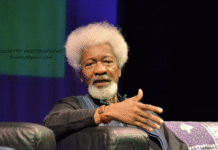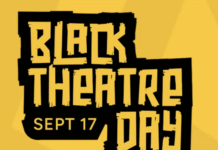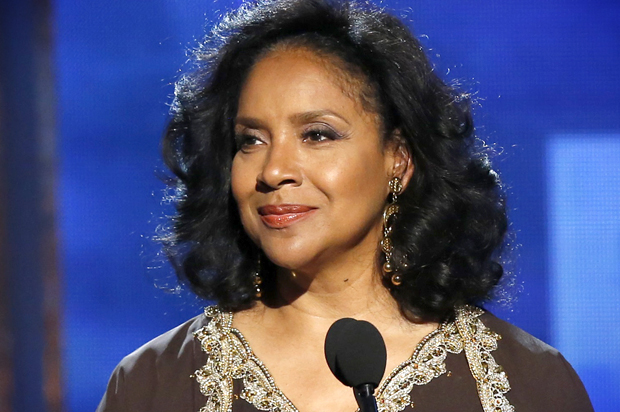
Who says black folks don’t create digital art? New media artists Mendi + Keith Obadike beg to differ, having worked in the field for well over a decade. In August 2001, Keith Obadike auctioned his Blackness on Ebay for $10 as performance art. This bold act helped usher in a “futurist sensibility” in using new media to question, subvert, deconstruct and reconstruct problematic ideologies. Recognizing the the web as a natural space to combine art, sound and text while having the ability to reach mass audiences, exploring digital space as art was a natural progression for the visual artists.
The married, multimedia/conceptual artist duo’s latest exhibition,“American Cypher” is now showing at The Studio Museum in Harlem through June 30th. This site-specific work is a suite of projects that respond to American stories about race and DNA. The project includes an eight-channel sound and video installation with a series of letterpress prints and a book. The dynamic duo will be hosting an artist talk at the Studio Museum on Sunday, June 9, 2013 at 3 p.m.
As a prelude to the talk, The Burton Wire caught up with the trailblazers to talk about the exhibit, the politics of DNA, black cultural production and digital media, and why Oprah Winfrey, Thomas Jefferson and Sally Hemings make such interesting subjects for this exhibit.
TBW: How did the opportunity to work with the Studio Museum come about?
M+K: We had the good fortune of being in an exhibition (Race in Digital Space) many years ago at the Studio Museum that was curated by Erika Muhammad (now Erika Massaquoi). We had also performed there in the past. Like many artists in our generation, we were influenced by artists and administrators associated with the Museum. As a result, we really see the Studio Museum as our community museum. We were living in Harlem until very recently, and had many friends involved with the museum (in residences and staff positions) over the years. It had been a while since we’d done anything at the institution, so we were pleased when Curatorial Assistant Abbe Schriber contacted us about a studio visit.
TBW: How did you decide that American Cypher was right for the Studio Museum?
M+K: During the studio visit with Schriber, we went through our current and upcoming projects. One of the projects was American Cypher, which had been commissioned by two institutions at Bucknell University — the Griot Institute for Africana Studies and the Samek Art Gallery. We decided that a site-specific version of American Cypher would work well at The Studio Museum.
TBW: What is American Cypher?
M+K: The project (American Cypher) considers the role of DNA in our current understanding of race and American identity through five stories about figures including scientists, members of the criminal justice system, and politicians. We begin with the story of the relationship of president Thomas Jefferson and Sally Hemings—who was his slave, his wife’s half sister, and the mother of some of his children. At the center of this project is an 8 channel sound art installation derived from a 200-year-old bell belonging to Sally Hemings. There is a short video piece projected onto one wall in the museum. There is also a series of letterpress prints hanging on the walls with text about each of the characters in our project. In the museum’s Reading Room there is a book that accompanies the exhibition and it includes poems about each character in our piece.
TBW: Many erroneously believe that blacks are at the margins of multimedia production and digital installations. Why do you think this myth continues to persist?
M+K: There is a general stereotype that Black people are not at the forefront of tech-based work in the arts or the commercial/industrial sector. This myth often goes unchallenged because there is often very little written about or scarce documentation of folks working in these fields. We don’t solely work in the digital realm, but it is where we did much of our early collaborations and certainly a part of the American Cypher project might be described as digital or multimedia. When we began this work together years ago, we saw this as a space where we could easily combine our individual backgrounds in music, poetry and visual art. Digital sounds, video, or interactivity are no longer unusual in the arts. We’ve been working together almost twenty years, and when we started there were very few people (Africans or people of color) working (in what was then called new media) in this way. But there was always a long, quiet history of a small Black community working in the digital and electronic trenches. In addition to decidedly non-digital folk like writer Toni Morrison and musician Pharoah Sanders, we were influenced by folks like Keith’s mentor Acha Debela, who has been working with CG since the 80s, British multimedia artist Keith Piper, and folks like composer/trombonist George Lewis.
In a small effort to combat this myth, we’d like to list a few folks in the experimental media arts field:
Auriea Harvey, Pamela Jennings, Robert Martin, Pamela Z, Ulysses Jenkins, Renee Green, Stan Douglas, Paul D. Miller (DJ Spooky), Camille Norment, Philip Mallory Jones, Kamau Patton, Cauleen Smith, Latasha Diggs, Torkwase Dyson.
TBW: You mentioned lack of documentation of this type of work done by black artists. What is your take on this issue?
M+K: Our work (the work of independent Black media artists) from the 1960s to the present has not been historicized adequately. The exhibition that we mentioned earlier, Race in Digital Space (2002), was one of the few major attempts made by a curator/critic to really give some context for this interdisciplinary work done by Black media artists over the last 40 years. There are very few critics or scholars working on this area of cultural production. Art made by Black people is mainly written about and seriously engaged by Black critics, Black art historians, and Black musicologists. We have few numbers in those ranks (art history/musicology) and there seems to be a general academic inertia towards more traditional and commercial forms. So we get this strange cycle (much like folks in the commercial / industrial tech world) where in addition to run of the mill racism deterring folks from working in an area, the work of Black media artists is not well documented because our numbers are small. Our numbers remain small because there is very little written about in the mainstream texts, so younger folks are not encouraged to enter the field. This has changed a bit since the rise of social media. We now see more artists connecting across zones and a little more documentation happening.
TBW: DNA has been a major factor in the exoneration of many convicted felons of color. How does this relate to your exhibit?
M+K: Our exhibition American Cypher, is made up of a series of true American stories told through sound, images and text, about DNA and identity. It is not, however, a documentary approach. We deal with these stories as a springboard for poetic reflection in an art context. One section of the piece focuses on DNA and the criminal justice system. The role of DNA in law enforcement is being hotly debated right now. While this science has aided in the exoneration of many innocent people, there are still many questions about when DNA material should be collected and what should be done with the material after it is collected. No matter how one feels this science should be used, what is clear is that there is a lot at stake for African-Americans in this process. As a way to think through these issues in our work we looked at two significant legal cases. We dealt with the story of James Bain, an innocent African-American man who was released after 35 years in jail when DNA evidence was allowed to be used in his defense. He served the longest sentence overturned by DNA evidence. In his case it was contemporary science triumphing over the often problematic “eyewitness testimony”. We also deal with the story of an African-American serial killer, Lonnie Franklin, known as the Grim Sleeper. He preyed mainly on African-American women and he eluded police for many years. He was captured when the police used information in a familial DNA database to track him. His son was arrested for a crime, this son’s DNA was collected, matched to the serial killer, and it led the police to the father. The capture of a serial killer is obviously a good thing. The debate begins when we recognize that DNA material from African-Americans is disproportionately collected in these police / FBI controlled databases and once one family member enters the system, then an entire group of relatives are now on record. Many states currently allow anyone arrested (wrongfully or justly) to be swabbed and entered into the database. Proponents say DNA collection is just the contemporary method of fingerprinting and not an overreach; opponents say this is an unusual invasion of privacy that will lead to even greater unjustified surveillance of Black and Brown communities.
TBW: With the many DNA stories that you could tell, why Sally Hemings and Thomas Jefferson?
M+K: The project was originally commissioned by Bucknell University’s Griot Institute for Africana Studies and the Samek Art Gallery as a public sound installation. They asked us to think about the relationship between Hemings and Jefferson. As we began our preliminary research, we began to see how much the DNA evidence that undeniably links the Hemings and Jefferson family lines affected the historical record. While there had been rumors that Jefferson had fathered Hemings’ children since the time in which they lived, the DNA evidence changed the way some members of the Jefferson family and some institutions talk about this story. For us, this opened the door to other conversations about the role of DNA in our understanding of roots, race, and American identity.
TBW: What other stories are covered in this project?
M+K: We address four additional stories in this iteration of the project. The first story is about Oprah Winfrey. A few years ago Winfrey met with Harvard Professor Henry Louis Gates on a PBS special and had her DNA tested to find her place of origin on the continent of Africa. Before tests were concluded she announced to the press that she was Zulu. This seemed highly unlikely since most African-Americans descended from enslaved Africans taken from the west coast of Africa. The DNA test later concluded that she was from Liberia. In this project, we really wanted to think about what Oprah’s Zulu fantasy meant. Other sections of our piece included the infamous discoverer of the double helix structure, James Watson, who in 2007 made racist statements about African genetic inferiority only to be outed later as being of African descent. In addition to the stories from the justice system that we mentioned earlier, we also look at popular stories about President Obama’s heritage. But the spark for all of this is the Hemings and Jefferson story. We see the Hemings/Jefferson story as an American origin story. It gets to the heart of two questions — Who gets to be American and how do we identify them?
TBW: What are your thoughts on the intersection of art and social justice?
M+K: One of our consistent goals has been to engage audiences in a dialogue about the codes that order our understanding of social place. We’ve pointed to this dialogue in a number ways across our projects, but we’re always trying to get ourselves and others to be more thoughtful about what it means to categorize living things.
We think justice, politics, history, and power will always be compelling subjects for artists. And of course art is extremely, extremely important, but an artwork about these subjects rarely brings about large scale political change or social justice. If social change is the goal, then direct political action seems much more effective. What art does do well is allow us to see our culture in new ways, imagine new possibilities, and to reflect on our values and our own humanity. And we don’t get necessary and effective political action without this kind of reflection and imagination.
TBW: Have you experienced any anti-intellectual feedback from the exhibit? If so, how did you address it?
M+K: No. When we receive feedback it is usually from people who have come to engage with ideas. Perhaps it is because the Studio Museum’s audiences expect the exhibitions to be “about something”. This is not necessarily the case with all art institutions and audiences. But in general, we really just try to make the work and let it do its thing. It’s not something we worry about for the most part. There are also a number of ways to engage with the work from the sound installation, to the book, prints, and video. The depth of engagement is, of course, up to the audience.
TBW: With all of the amazing exhibitions taking place in New York this summer, why should “American Cypher” be at the top of the list?
M+K: There are always many great things to see in this city and it is a privilege to be in the mix. See as many as you can and be enriched. We’d be honored if folks stopped by to experience our offering.
The American Cypher exhibit will be at the Studio Museum in Harlem until June 30, 2013. Please note that Sundays are free at the Studio Museum (144 West 125th Street). Keith + Mendi can be found at Obadike.com. Like them on Facebook and follow them on Twitter @MendiandKeith.
This article was written and edited by Nsenga K. Burton, Ph.D., founder & editor-in-chief of The Burton Wire, an award-winning news site dedicated to covering news, opinion and culture of the African Diaspora.
Like The Burton Wire on Facebook. Follow us on Twitter @TheBurtonWire.










In two years of required Ph.D. coursework in digital media not one of the texts discussed black and brown artists. I had to go it by myself and include them and their work in my comprehensive oral exam… that took defiance. It also led to feelings of marginalization and isolation. I was undeterred but I wish things were different.
Comments are closed.